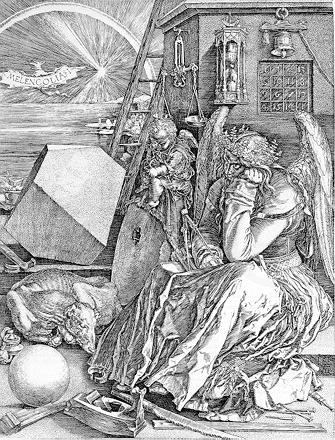This week’s picture is Albrecht Durer’s celebrated engraving, Melencolia I: an appropriately sombre image for a rather gloomy time of year. The work is currently on display in the Prints and Drawings Department of the British Museum, in an exhibition devoted to the graphic art of Renaissance Germany’s most prolific and original draughtsman: “Durer and His Legacy”.
The Melencolia has provoked reams of speculative interpretation but its meaning has not been definitively established. The seated figure in Durer’s print seems trapped by some kind of despair, or at least a form of tormenting creative block. Head resting heavily on one hand, sitting glumly on the step of a half-finished building (the ladder propped against it indicates that construction has been interrupted), the cloaked and winged melancholic is surrounded, almost overwhelmed even, by the tools of labour: a grindstone on which an indolent, seated putto dozes; a pair of pincers; a hammer, a plane, a saw, a ruler and some bent nails; a small crucible with a pair of tongs beside it. Evidence of now abandoned enterprises are to be found in the form of a perfectly turned sphere of wood and, above it, of a partially worked rhomboid of cut stone. The slouched and morose melancholic appears to be an agonised artist: a creative individual who, for some reason, cannot bear to create.
Many of Durer’s own contemporaries were mystified by the picture. To most of them melancholy was simply one of the so-called “four humours”, which since late antiquity had been held to constitute and determine the nature of man. Everyone was believed to suffer from an excess of one or other of these humours, which would determine the nature of his or her physique and character. The melancholy disposition was generally regarded as the least desirable...


